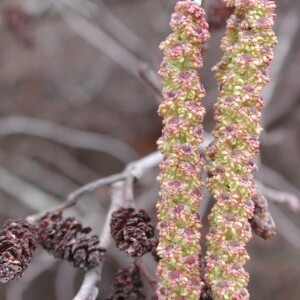Monoecious, mostly deciduous shrubs or trees with perular buds. Pith triangular in section. Innovations often resmiferous. Leaves simple, (in Mal. spp.) spiral, penninerved, crenate or dentate, rarely entire, mostly with domatia in the nerve-axils beneath, in bud mostly folded along the midrib and plicate, often glandular-lepidote beneath. Stipules caducous. Catkins unisexual, at least the pendent male ones in terminal panicles above the female ones, the latter mostly in stiff, axillary, poor racemes or terminal on short-shoots. Male flowers in triads, each sustained by a bract. Perianth segments 4 (or less by abortion), mostly connate at the base. Stamens 4, epitepalous; filaments short; anthers glabrous, 2-celled; cells parallel, dehiscing lengthwise. No rudiment of female. Female flowers in diads sustained by a bract concrescent with 4 bracteoles, accrescent and woody in fruit, densely packed and imbricate. Perianth 0. Ovary 2-celled, each cell with one anatropous, pendent ovule attached near the apex of the cell; styles 2, free, short, cylindric. Fruiting catkins cone-like. Nut small, compressed, 1-seeded, mostly winged and crowned by the styles. Seed without endosperm; embryo straight; cotyledons flat; testa membranous; endosperm 0.
Terminal buds present; stipules caducous. Staminate catkins borne at the end of last year's leaf shoot; cymules 3-flowered (often reduced at distal portion of catkin), subtended by a primary bract, 2 secondary bracts and each lateral flower by a single abaxial bract (rarely an adaxial bract develops); tepals 0-6; stamens 4(-6), adnate to the tepals. Pistillate catkins borne on few-leaved dwarf-shoots or borne in a leaf axil subtending the staminate catkin, often several lateral catkins develop to form a raceme, each cymule composed of 2 lateral flowers, the bracts as in staminate cymules; perianth reduced to !small glands which are sometimes adnate to the ovary; the catkin at maturity resembling a small cone; ovary 2-or 3-carpellate. Fruit a nut more or less winged. The presence of polymerous flowers in the same cymule is not unusual. Hermaphroditic flowers are sometimes found toward the base of the catkin (either staminate or pistillate).
Trees or shrubs deciduous. Buds stalked with 2(or 3) scales or sessile with several overlapping scales. Leaves usually serrate or dentate, rarely incised or entire. Male inflorescence elongate, pendulous, cylindric, with numerous overlapping bracts, each bract subtending (3 or)4(or 5) bracteoles and 3 flowers; calyx 4-lobed; stamens (1-)4; anthers 2-loculed, thecae connate, apex glabrous. Female inflorescence 1, or 2-numerous in a raceme or panicle, ovoid or ellipsoid, conelike; bracts numerous, overlapping, woody, persistent, apex 5-lobulate, each bract subtending 2 flowers. Nutlets 2 in each bract axil, compressed, with membranous or papery wings. Fl. mainly spring, Alnus formosana and A. nepalensis autumn.
Staminate catkins pendulous, usually clustered, each bract subtending 3 fls with minute, 4-parted cal and 4 stamens with short, undivided filaments; pistillate catkins becoming woody, long-persistent, short, ovoid to ellipsoid or short-cylindric, each bract subtending 2 fls without cal; bracts of the pistillate catkins adnate to the bractlets, the compound unit cuneate, rounded or truncate and lobed at the summit; fr a small achene or samara, crowned with the 2 short, persistent styles and surrounded by a thin margin or membranous wing; trees or shrubs with 3-angled pith and broad, ovate to obovate, deciduous lvs. 30, mostly N. Hemisphere.
Trees or shrubs. Buds either stalked with 2-3 scales (subgen. Alnus Endl.), or less often sessile with 3-6 imbricate scales (subgen. Alnaster Endl.). Lvs usually serrate or dentate. ♂ catkins: bracts peltate with 4 bracteoles to each; stamens usually 4, beneath bract. ♀ catkins < ♂, with 2 fls to each bract and bracteoles. Fruiting catkin cone-like, ovoid to ellipsoid, long-persistent. Scales 5-lobed or truncate, woody. Fr. a nutlet, usually winged, 2 in the axis of each scale.
Trees or shrubs. Inflorescence composed of dichasia; dichasia each with 1 bract and 2 bracteoles. Male flowers 3 per dichasium; perianth usually 4-partite. Female flowers 2 per dichasium; perianth absent. Infructescence cone-like, ovoid or ellipsoidal; scales 5-lobed, thick, woody, persistent.

